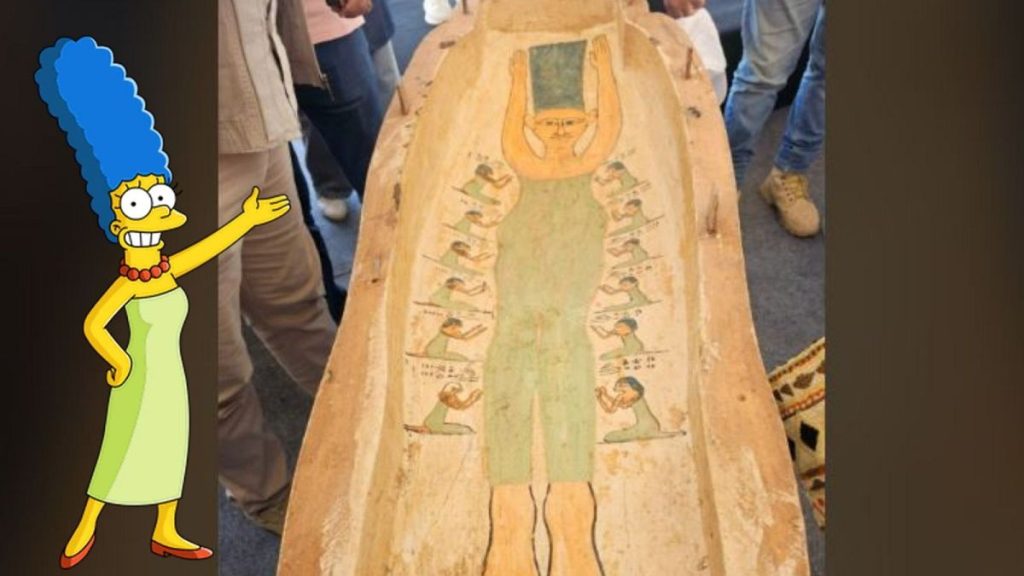The internet has recently been abuzz with excitement over an archaeological discovery in Egypt that seems to blur the lines between ancient history and popular culture. A 3000-year-old tomb unearthed in the ancient cemetery of Minya, located on the western bank of the Nile, features a painting that bears a striking resemblance to Marge Simpson, the iconic blue-haired matriarch of the animated sitcom, The Simpsons. This unexpected find has sparked widespread amusement and speculation online, adding another layer to the already prevalent theory that The Simpsons has a knack for predicting future events.
The painting in question depicts a woman with yellow skin, a blue crown or headdress, and a green outfit, echoing Marge’s signature appearance. The image quickly went viral on social media platforms, particularly on a Reddit thread aptly named "ArtefactPorn." Users expressed their astonishment at the resemblance, with comments ranging from humorous disbelief to playful assertions that The Simpsons has once again proven its uncanny ability to foreshadow reality, albeit this time in reverse. This discovery has added a new dimension to the "Simpsons predict" phenomenon, suggesting that the show’s influence might extend even further back in time than previously imagined.
While the internet revels in the humorous parallels between the ancient painting and the modern cartoon character, it’s important to acknowledge the historical context of the artwork. Experts have identified the figure in the painting as Tadi Ist, the daughter of a high priest in El-Ashmunein. The tomb itself dates back to the New Kingdom, 20th Dynasty (circa 1186-1069 B.C.). The excavation of the tomb also yielded other significant artifacts, including ornaments, amulets, and coffins, shedding light on the burial practices and beliefs of that era. Mostafa Waziry, the Secretary General of the Supreme Council of Antiquities, emphasized the rarity and importance of the scene depicted in the painting, highlighting its unique artistic representation within the context of ancient Egyptian funerary art.
The discovery of the "Marge Simpson" painting has reignited the ongoing discussion about The Simpsons and its apparent ability to predict future events. This theory, often fueled by the show’s long run and its satirical commentary on contemporary society, has gained traction over the years with several instances where real-world events seemed to eerily mirror plotlines from past episodes. From predicting Donald Trump’s presidency to foreseeing technological advancements, The Simpsons has earned a reputation for its seemingly prescient storytelling. The Egyptian tomb painting adds a humorous twist to this narrative, suggesting that the show’s influence might transcend time itself.
Beyond the lighthearted comparisons and internet memes, the discovery of the Tadi Ist painting offers valuable insights into ancient Egyptian art, religion, and social structures. The depiction of Tadi Ist, the daughter of a high priest, reveals information about the social hierarchy and the roles of women in that society. The vibrant colors and stylized representation are characteristic of ancient Egyptian art, showcasing the artistic conventions and symbolism prevalent during the New Kingdom period. The tomb itself, along with the accompanying artifacts, provides a glimpse into the burial practices and beliefs of the time, offering a window into the lives and afterlives of ancient Egyptians.
In conclusion, while the resemblance between the ancient Egyptian painting and Marge Simpson is undeniably amusing, it’s crucial to appreciate the historical significance of the discovery. The image of Tadi Ist represents more than just an internet meme; it serves as a tangible link to a rich and complex past, offering valuable insights into the art, culture, and beliefs of ancient Egypt. While the humorous comparison to a modern cartoon character has captured the public’s imagination, it’s important to remember the true value of this archaeological find lies in its contribution to our understanding of history and the human experience. The "Marge Simpson" painting, in its own unique way, bridges the gap between ancient and modern, reminding us of the enduring power of art and the surprising connections that can emerge across millennia.














